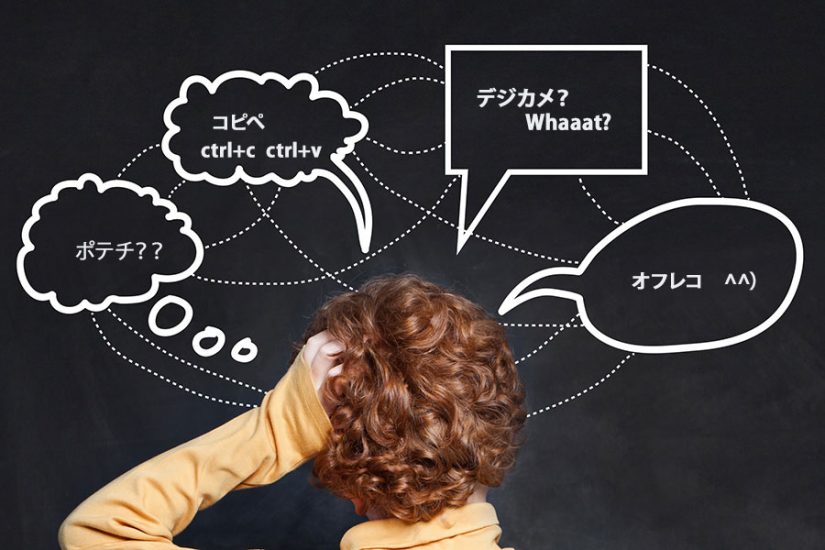Last time, we started on our trip through the more obscure or unexpected twists and turns of learning Japanese (but not the harder parts; the list of kanji is that way if that’s what you want) with an overview of some abbreviations. This time, we’ll pick up where we left off with one particular example, but we’re also going to be taking a look at bits and pieces of all sorts of other things that wouldn’t fill a full article by themselves.
In particular, last time, we touched on some katakana abbreviations that compress two words into one, usually the first few letters of each word. Katakana is loanwords practically all the way down, so you know some of these already, which I won’t be padding this article with. Instead, let’s go over some abbreviations that, while usually derived from English, only exist in Japanese. Here are a few examples, where I’ll be listing the Japanese, but also an English transliteration.
パソコン (pasokon): Personal computer. In recent years you’ll see PC as well, mostly in the context of shops that need to save sign space, but this is what people will actually say.
スマホ (sumaho): Smartphone. This came up in the previous article.
ボールペン/シャーペン (respectively bо̄rupen and shaapen): The first is short for ballpoint pen. The second one refers to a mechanical pencil, or propelling pencil in UK English. It’s short for ’sharp pencil’, after the Ever-Ready Sharp Pencil by, well, Sharp. This also makes it an example of genericide: A brand becoming so well-known that it becomes the generic word for a type of product.
リストラ (risutora): Short for restructuring, but the connotations are different. In Japanese, it just means getting fired, though usually with connotations that you weren’t the only one, or that it wasn’t particularly your fault.
SNS: This is an odd one because it’s an existing abbreviation for Social Networking Services in English too. The difference is mostly how commonly used the term is. In Japan, people will use SNS any time you might say ’social media’ in English.
口コミ (kuchikomi): Verbal communication. In practice, it refers to a specific way of spreading the reputation of something, and most often indicates something being advertised by word of mouth, rather than formally.
ピアス (piasu): Or ’pierce’. This is more of a slight variation, because it indicates any piercing.
— コン (-kon): This gets a bit involved. I know we touched on pasocon/pasokon before, but it goes further. Ending in this is very, very common, because among other things, it covers abbreviations for things ending in ’computer’ (famikon) is another example), ’conditioner’ (エアコン, or eakon, for air conditioner), ’contest’, control (リモコン, or rimokon, for remote control), and much more. As endings for katakana abbreviations go, it’s the most common, but it could mean a lot of different words, so you’ll need to be careful.
チョコ/ポテチ (choco, potechi): Easy ones for a second, relatively speaking. The first is for chocolate. The second is an abbreviation of potato chips (crisps for UK English speakers). You’ll see the first used a lot, but the second mostly keeps to informal spoken Japanese.
フリマ (Furima): Flea market.
スケブ (Sukebu): Sketchbook. Mostly only in spoken Japanese, though I think there might be an art site by the same name now or something.
ケンタ (Kenta): KFC/Kentucky Fried Chicken.
ハイデフ (Haidefu): High-definition (but derived from ’high-def’).
インフラ (Infura): Infrastructure.
オフレコ (Ofureko): Off the record.
クレカ (Kureka): Credit card. Only ever used informally and verbally, in my experience.
カーナビ (Kaanabi): Car navigation system.
エンタメ (Entame): Entertainment. This is a bit of an odd one in what parts it takes out of the original word, since it doesn’t follow the typical structure.
ケータイ (Keitai): From keitai-denwa, or ’portable phone’. Mostly went out of use, roughly when people started saying ’smartphone’ instead of ’cell phone’. I still use it to refer to smartphones, though, and it’s possible that others do as well.
コピぺ (Kopi-pe): Copy-and-paste.
デパート (Depaato): Or ’depart’.It’s short for department store, and so common that I almost forgot it’s short for something. Useful to know.
テレ— (Tere-): The standard format for abbreviating a television channel, especially regional ones, is to use ’tere’ and add the first kanji of the region it’s for, such as テレ朝for Asahi Television. However, some exceptions exist, like Nichitere (日テレ) for Japanese television as a whole.
デジカメ (Dejikame): Digital camera.
ポテト (Poteto): Contrasting ポテチ above, this one is used a bit more often as short for フライドポテト (furaido poteto, fried potato), and refers to chips (or for a US audience, French fries).
ヤフオク (Yafuoku): Yahoo Auctions, which doesn’t have that much presence outside Japan but is very prominent here. eBay might be a good comparison in the west.
I could go on forever, but it would get boring, and only less useful from here, so let’s move on from our list and examine two other phenomena. One is blue and green. For a long time, Japan used ’red’ to describe warmer colours, ’blue’ for cooler ones. This changed somewhere in the Heian era (794–1185), but you can still feel its effects today in one way. Lots of green things will be described as ’ao’ (blue), despite a word for green existing. This extends to traffic lights too: Most are just called blue for the green light, but Japan is one of the few that hasn’t signed the agreement to (among other things) standardise traffic lights to red, yellow and green. So in other words, if you see a blue traffic light, that’s not your eyes playing tricks on you: It really is blue. Most are still green, though.
One more phenomenon to briefly touch on: As a sort of pushback against shared systems, borrowing, or using what the shop gives you, there’s been a surge for over a decade now of terms beginning in ’My’. The most obvious of these is ’My Number’ for personal government-issued ID, but there are other examples too: ’My Car’ for… your car as opposed to carpooling, renting or taking a taxi, for example. ’My Bag’ is a very common one as well, for bringing your own container (bag or otherwise) to a shop so you don’t need plastic shopping bags. This one doesn’t need an exhaustive list of examples. You see a word starting with ’my’ and you probably get the idea, but it’s an interesting phenomenon.








